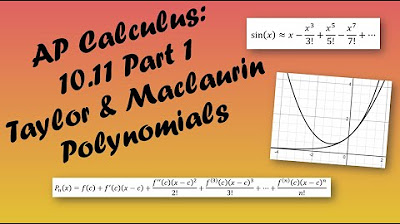Taylor Polynomials Day 1
TLDRThis educational video script delves into the concept of Taylor polynomials and their use in approximating functions such as sine and natural logarithm. It demonstrates how to graph these polynomials and their close approximation to the actual functions near zero. The script guides through the process of deriving the Maclaurin polynomial for sine of X and a sixth-degree Taylor polynomial for the natural log of X, centered at one. It also discusses the limitations of these approximations as the value of X moves away from the center point, highlighting the increased error in approximation as X approaches two for the natural log polynomial.
Takeaways
- 📚 The lesson is about Taylor polynomials and their use in approximating functions, specifically focusing on sine and natural logarithm functions.
- 📈 The instructor demonstrates graphing sine of X and a Taylor polynomial to show their closeness near zero and their divergence as X moves away from zero.
- 🔍 The concept of polynomials as a sum of terms with powers of X is introduced, and their utility in approximating transcendental functions is highlighted.
- 🎓 The definition of an nth degree Taylor polynomial is given, and the special case of a Maclaurin polynomial, which is a Taylor polynomial centered at zero, is explained.
- 🔢 The process of finding the Maclaurin polynomial involves calculating the derivatives of the function at the center point (in this case, zero) and plugging these values into the polynomial formula.
- 📝 The script provides a step-by-step example of finding the fifth-degree Maclaurin polynomial for the sine function by calculating its derivatives and evaluating them at zero.
- 📉 The instructor discusses the error of approximation, showing how it increases as the value of X moves further away from the center of the polynomial (in this case, zero).
- 📚 Another example is given for the natural logarithm function, where the sixth-degree Taylor polynomial is constructed around the point X equals one.
- 📝 The derivatives of the natural logarithm function are calculated, and a pattern in the coefficients and factorials of the Taylor polynomial is observed.
- 📉 The script also covers the graphing of the natural logarithm function and its corresponding Taylor polynomial, noting the polynomial's accuracy near the center and its divergence further away.
- 🛠️ The use of a calculator to evaluate the Taylor polynomial at specific points and to compare it with the actual function values is demonstrated, along with calculating the error of approximation.
Q & A
What are Taylor polynomials used for?
-Taylor polynomials are used to approximate functions, especially transcendental functions like sine, natural logarithms, and others.
What is a polynomial?
-A polynomial is an algebraic expression consisting of variables and coefficients, involving only the operations of addition, subtraction, multiplication, and non-negative integer exponents of variables.
What is the significance of the term 'Maclaurin polynomial'?
-A Maclaurin polynomial is a special case of a Taylor polynomial where the center of expansion is zero. It's named after Colin Maclaurin.
How is the degree of a Taylor polynomial determined?
-The degree of a Taylor polynomial is determined by the highest power of x in the polynomial, which corresponds to the highest derivative of the function used in its construction.
What is the process of finding the Maclaurin polynomial for a function?
-To find the Maclaurin polynomial, one must calculate the derivatives of the function, evaluate them at the center of expansion (usually zero), and then apply these values to the general formula for a Taylor polynomial.
How do you calculate the error of a Taylor polynomial approximation?
-The error of a Taylor polynomial approximation is calculated by finding the absolute value of the difference between the actual function value and the value given by the Taylor polynomial at a specific point.
What happens to the error of a Taylor polynomial as you move away from the center of expansion?
-As you move further away from the center of expansion, the error of the Taylor polynomial approximation generally increases because the polynomial is less accurate far from the center.
What is the general formula for an nth degree Taylor polynomial?
-The general formula for an nth degree Taylor polynomial is given by the sum of the function's derivatives at the center of expansion, divided by the corresponding factorials, multiplied by the powers of (x - center), starting from the zeroth derivative up to the nth derivative.
How does the pattern of coefficients in the Taylor polynomial for natural log of x centered at 1 simplify?
-The coefficients in the Taylor polynomial for natural log of x centered at 1 simplify because each term's coefficient is one less than the factorial in the denominator, leading to a pattern where the factorials cancel out all but the first factor of the power of (x - 1).
What is the significance of the nth derivative in the construction of a Taylor polynomial?
-The nth derivative is crucial in the construction of a Taylor polynomial because it determines the coefficients of the terms in the polynomial up to the nth degree, which in turn affects the accuracy of the approximation.
Outlines
📚 Introduction to Taylor Polynomials and Graphing
The script begins with an introduction to Taylor polynomials, which are used to approximate functions, particularly transcendental ones like sine. The instructor demonstrates how to graph the sine function alongside a Taylor polynomial approximation, showing how closely they match near the origin but diverge as the value of X moves away from zero. The concept of a Taylor polynomial is explained, including its definition and the special case of a Maclaurin polynomial, named after Colin Maclaurin. The focus then shifts to constructing a fifth-degree Maclaurin polynomial for the sine function, involving calculating its derivatives and evaluating them at zero.
🔍 Evaluating and Comparing Taylor Polynomials
This section delves into calculating the fifth-degree Taylor polynomial for sine at specific points, such as 1.4, and comparing these values with the actual sine values to assess the approximation's accuracy. The script explains how to find the error of the approximation by taking the absolute difference between the polynomial's value and the function's value. The instructor also discusses the behavior of the error as the point of evaluation moves further from the center of the polynomial, noting an increase in error at greater distances.
📈 Constructing a Taylor Polynomial for Natural Logarithm
The script moves on to constructing a sixth-degree Taylor polynomial for the natural logarithm function, centered at X equals 1. This involves finding the function's derivatives up to the sixth order and evaluating them at the center point. The process highlights the pattern that emerges when constructing Taylor polynomials, where the coefficients are related to the factorial of the polynomial's degree minus one. The instructor simplifies the polynomial to reveal a clear pattern and then evaluates the polynomial at 1.8, comparing it to the actual natural logarithm value to discuss the approximation's error.
📘 Graphing and Analyzing Polynomial Approximations
The final paragraph discusses graphing the natural logarithm function and its sixth-degree Taylor polynomial approximation on a calculator. The instructor points out the close match between the two near the center but notes a significant divergence at larger values of X. The script concludes with a brief mention of the calculator's Taylor command, which can be used to build and check Taylor polynomials, and a teaser for the next class, where the students will practice constructing polynomials and review free response questions.
Mindmap
Keywords
💡Taylor Polynomials
💡Approximations
💡Sine Function
💡Natural Logarithm
💡Derivatives
💡Factorial
💡Maclaurin Polynomial
💡Error of Approximation
💡Graphing
💡Transcendental Functions
Highlights
Introduction to Taylor polynomials and their use in approximating functions.
Graphing sine of X and a polynomial approximation to compare their similarity.
Taylor polynomials can approximate transcendental functions like sine and natural log.
The difference between the sine graph and the polynomial graph becomes apparent as X moves away from zero.
Definition of an nth degree Taylor polynomial and its relation to derivatives at a point C.
Maclaurin polynomials are a special case of Taylor polynomials centered at zero.
Derivation of the Maclaurin polynomial for sine of X up to the fifth degree.
Calculation of the fifth degree Taylor polynomial's value at 1.4 and comparison with the actual sine value.
The error in approximation increases as the value of X moves further from the center of the polynomial.
Derivation of a sixth degree Taylor polynomial for the natural log of X centered at 1.
Graphing the natural log of X and its sixth degree Taylor polynomial to observe their closeness near the center.
The Taylor polynomial for natural log of X breaks down at X equals 2, indicating a limitation of the approximation.
The TI-89 calculator has a Taylor command to build Taylor polynomials for verification.
Building a third degree Taylor polynomial for a function G centered at 2 using given derivatives.
The importance of understanding the formula for Taylor polynomials and how to apply it to various functions.
Transcripts
Browse More Related Video

Avon High School - AP Calculus BC - Topic 10.11 - Example 2

AP Calculus BC Lesson 10.11 Part 1

AP Calculus BC Lesson 10.14 Part 1

Taylor & Maclaurin polynomials intro (part 2) | Series | AP Calculus BC | Khan Academy

2011 Calculus BC free response #6d | AP Calculus BC | Khan Academy

Avon High School - AP Calculus BC - Topic 10.12 - Example 3
5.0 / 5 (0 votes)
Thanks for rating: